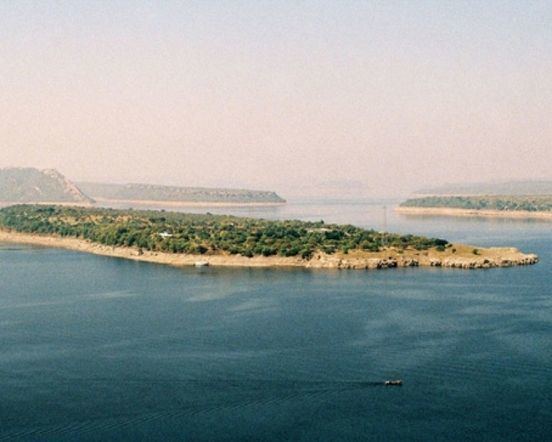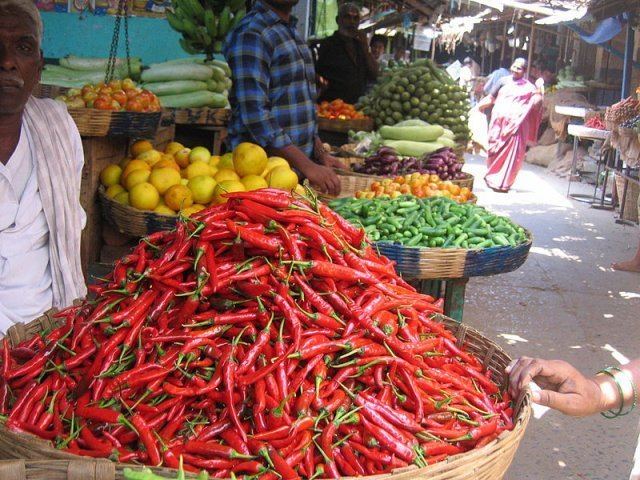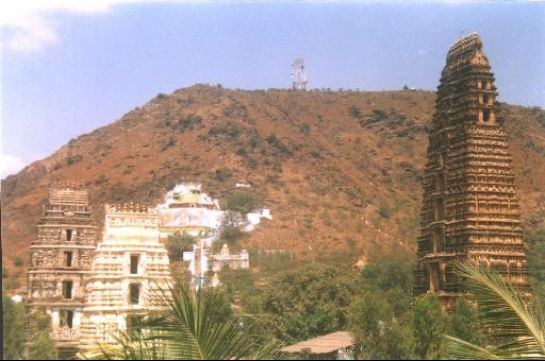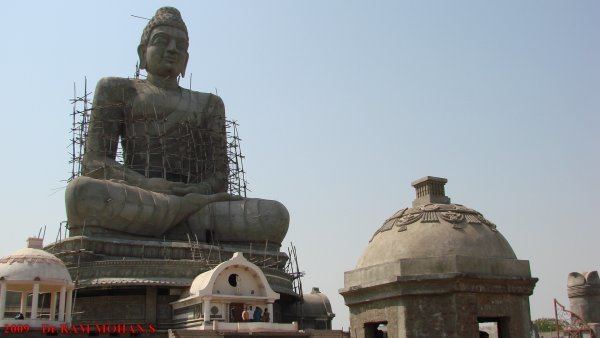Country India Area 45.71 km2 Region Coastal Andhra | Language spoken State District Guntur | |
 | ||
Colleges and Universities Acharya Nagarjuna University, Vignan University, RVR & JC College of Engineering, K L University, Guntur Institute of Medical Sciences | ||
Map of Guntur
Guntur ( pronunciation ); is a city within the Andhra Pradesh Capital Region. Located 35 km (22 mi) away from the state capital Amaravati, Guntur city is the administrative headquarters of Guntur district, of the Indian state of Andhra Pradesh. It is a municipal corporation and also the headquarters of Guntur mandal in Guntur revenue division. It is situated on the plains at a distance of 40 miles (64 km) to north of the Bay of Bengal. The city is the third most populous settlement in the state with a population of 743,654 as per 2011 census of India
Contents
- Map of Guntur
- Place between gunturvijayawada is the best option for capital construction
- Andhra delicacies that left our highwaymen smacking their lips
- Etymology
- History
- Geography
- Climate
- Demographics
- Civic administration
- Utility services
- Law and order
- Healthcare
- Economy
- Culture
- Cuisine
- Cityscape
- Transport
- Education and research
- Media
- Sports
- References

Guntur is classified as a Y-grade city as per the Seventh Central Pay Commission. It forms a part of Vishakhapatnam-Guntur Industrial Region, a major industrial corridor in the country. The city is known for chilli export and has the largest chilli market yard in Asia.
Place between gunturvijayawada is the best option for capital construction
Andhra delicacies that left our highwaymen smacking their lips
Etymology

The earliest reference to the present name of the city can be dated back to the period of Ammaraja–I (922-929 CE), the Vengi Eastern Chalukyan King. It also has its appearance in another two inscriptions dated 1147 AD and 1158 AD. In Sanskrit, the name of Guntur was referred as Garthapuri. Garthapuri or Guntlapuri translates to a place surrounded by water ponds. The settlement might have been near a pond (gunta in telugu) and hence, gunta uru refers to pond village. Another one refers to kunta (land measuring unit) which transformed to kunta uru and later to Guntur.
History

The earliest recorded reference of Guntur comes from the Idern plates of Ammaraja I (922–929 CE), the Vengi Chalukyan king. French astronomer, Pierre Janssen observed the Solar eclipse of 18 August 1868 and discovered helium, from Guntur in Madras State, British India. The inscriptions stones in the Agastyeshwara temple in 'Naga Lipi' (an ancient script) dates back to about 1100 CE. It is considered one of the most famous temples in the city. It is said that Agastya built the temple in the last Treta Yuga around the swayambhu linga and hence it has this name. The 'Nagas' were said to have ruled the region at that time. The region has been historically known for Buddhism and the first Kalachakra ceremony performed by Gautama Buddha himself. The place of Sitanagaram and the Guttikonda caves are referred in the ancient texts (Vedic puranas) going back to the Treta Yuga and Dwapara Yuga (Traditional time scale: 1.7 to 0.5 million years ago, Ref).

With the arrival of the Europeans in the late sixteenth century the city attained national and international significance. The French shifted their headquarters from Kondavid Fort to here in 1752, probably because of the ample availability of water due to the two large tanks. This settlement formed the nucleus of the modern city. The Nizams and Hyder Ali also ruled the city until it came under British rule in 1788. It was made the headquarters of a district named after it that was abolished in 1859, only to be reconstituted in 1904. The city rapidly became a major market for agricultural produce from the surrounding countryside due to the opening of the railway link in 1890. The expansion continued post independence as well and was concentrated in what is now called "New Guntur", with many urban areas such as Brodipet, Arundalpet and suburban areas like Pattabhipuram, Chandramouli Nagar, Sita Rama nagar, Brindavan Gardens, etc.
Geography

Guntur Plains: Guntur is at 16.29°N 80.43°E / 16.29; 80.43. It has an average elevation of 33 m (108 ft) and is situated on the plains. There are a few hills in the surrounding suburban areas. The city is around 40 miles (64 km) to the west of the Bay of Bengal on the east coast of India. The Krishna delta lies partly in the Guntur district. There are other smaller rivers and channels in the region such as Guntur Channel, Chandravanka, Naagileru, Guntur Branch Canal etc.
As quoted in NASA's website "it is typical of the wider deltas along the southeast coast of India (known as the Coromandel Coast). The braided stream channels, broad floodplain, and extensive sandbars suggest that this part of the Krishna River flows through relatively flat terrain and carries a substantial amount of sediment, especially during the monsoon season."
Climate
As per Köppen-Geiger climate classification system the climate in Guntur is tropical (Aw). The average temperature is warm to hot year-round. The summer season (especially during May/June) has the highest temperatures, but these are usually followed by monsoon rains. The winter season (from November to February) is the most enjoyable with a pleasant climate. Winter months are usually dry, with little to no rainfall. The wettest month is July. The average annual temperature is 28.5 C and annual rain fall is about 905 mm. Rain storms and cyclones are common in the region during the rainy season, which starts with the monsoons in early June. Cyclones may occur any time of the year, but occur more commonly between May and November.
Geography
The city is situated on the plains and located 40 miles (64 km) to north of the Bay of Bengal. It is surrounded by small hills and Perecherla Reserve Forest on the west. River Krishna is the main source of water for the city through channels and tributaries.
Demographics
In the 1961 census, Guntur had a population of 187,122 and increased to 516,461 in 2001, which shows a considerable growth during the last 5 decades. As of 2011 census, the city had a population of 651,382. It then increased to 7,43,354 after expansion, constituting 371,727 males and 3,71,612 females —a sex ratio of approximately 1000 females per 1000 males, higher than the national average of 940 per 1000. The urban agglomeration population of the city is projected to be approximately, 1,028,667.
Hinduism is the major religion in Guntur. Telugu is the main language of communication in the city. One of the earlier forms of Telugu language can be noticed in this region. Most of the Muslims in the city speak Urdu as their mother tongue. One of the purportedly lost tribes of Israel called Bene Ephraim, has its presence in Guntur, with a Jewish synagogue as well.
Civic administration
In 1866, Guntur was made a municipality with a population of about 25,000. It was upgraded to III (1891), I Grade (1917), special grade (1952) and selection grade in 1960. Later, in 1994 it was made a "Municipal Corporation". In 1995, the first election of the Municipal Corporation was conducted. In the year 2012, the city limits were expanded by merging ten surrounding villages into the Guntur Municipal Corporation. The present commissioner is S. Nagalakhsmi. The corporation budget is ₹973.24 crore (US$150 million). Recently the corporation topped the charts in property tax collections in the state.
The city is one among the 31 cities in the state to be a part of water supply and sewerage services mission known as Atal Mission for Rejuvenation and Urban Transformation (AMRUT). In 2015, as per the Swachh Bharat Abhiyan of the Ministry of Urban Development, Guntur Municipal Corporation was ranked 70th in the country. The Guntur Municipal Corporation received the open defecation free city certificate as part of Swacch Bharat Mission.
Utility services
River Krishna is the main source of water for the city through channels and tributaries.
Law and order
The High Court was in Guntur after the separation from the erstwhile Madras State, which was later moved to Hyderabad after the formation of Andhra Pradesh. Guntur Urban and Rural police offices oversees the law and order for the city and the rural areas surrounding it. The city is also the headquarters for Agricultural Marketing Department, NCC Group and also hosts one of the Indian Army recruitment and training centers.
Healthcare
The Government General Hospital provides free health care to people across the district.
Economy
The city is headquarters to Agricultural Marketing Department. Agriculture Market Committee Market Yard, the largest chilly yard of Asia, generates an income of upto ₹100 crore (US$16 million) during trading season. The spiciest Guntur chillies are exported to foreign countries and in terms of trade the city stands second, next to Mexico. Commercial activities are concentrated mostly on outlets such as, cinema halls, malls, jewellery, fertilisers etc.
Culture
The city residents are referred as Gunturians. Traditional drama and theatrical events also have their presence in the city. The city has various religious presence and hence, many festivals such as, Eid al-Adha by Muslims; Hindu festivals of Diwali, Holi; and Christmas by Christians; etc., and many more.
Cuisine
The South Indian breakfast varieties such as, Idli, Dosa etc., are preferred mostly. The Red chilli biryani is one of the native dish from the area. Guntur Sannam, a chilli variety was registered as one of the geographical indication from Andhra Pradesh under the Geographical Indications of Goods (Registration and Protection) Act, 1999.
Cityscape
The major commercial and residential areas in the city include the Arundelpet, Lakshmipuram and Brodipet. Navabharath Nagar, Pattabhipuram, Shyamla Nagar and Vidya Nagar etc., are some of the other areas in the city. Autonagar, Gorantla, Peda Palakaluru, Nallapadu, Chennai Highway etc. are some of the other areas of the city.
The city has many parks, museums, temples, nature conservation sites, forts, resorts and caves. The Jinnah Tower is one of the iconic structure on Mahatma Gandhi Road, one of the important centre of the city. There are seventeen parks in the city with some of them maintained by the municipal corporation.
Transport
The local transport preferred by the city commuters include, privately operated auto rickshaws, cabs, mini-buses and a few government run APSRTC buses in specified routes. The NTR bus station of the city operates suburban and long distance services. In the recent times, it has introduced city bus services to the nearby destinations of Pedakakani, Namburu, Yanamadala and Chebrolu. As the city doesn't have dedicated city bus services, there is a proposal for a new city bus depot at Pedakakani for operating them. The Rail Vikas Bhavan at Pattabhipuram in the city is the headquarters of Guntur railway division. Guntur Junction and New Guntur railway stations of the city provides rail transport. While, Nallapadu and Perecherla railway stations serves as satellite stations. The Guntur railway station operates MEMU and local trains for the one lakh commuting population, including thousands of university students. Though there was a proposal to build a no frills airport for the city, the Vijayawada International Airport located at Gannavaram serves the air travel needs of the city commuters.
The city has a total road length of 853.00 km (530.03 mi). The Mahatma Gandhi Inner Ring Road is an arterial road with a stretch of 6.34 km (3.94 mi), that encircles the city with its start and end points on NH 16. The other arterial city roads include, the Grand Trunk Road, JKC College Road, Lakshmipuram Road, Pattabhipuram Road and Palakaluru Road etc. The city is connected to major destinations by National highways, State highways and district roads. National Highway 16 bypasses the city, which is also a part of Asian Highway 45 and Golden Quadrilateral. The State Highway 2 connects the city with Macherla and State Highway 48 with Bapatla and Chirala. The Guntur–Amaravati, Guntur–Nandivelugu and Guntur-Parchoor roads are the district roads connecting their respective destinations.
Education and research
The primary and secondary school education is imparted by government, aided and private schools, under the School Education Department of the state. As per the school information report for the academic year 2015–16, the city limits (including the merged villages) have more than one lakh students enrolled in over 400 schools. The Central Board of Secondary Education, Secondary School Certificate or the Indian Certificate of Secondary Education are the different types of syllabus followed by different schools. The medium of instruction followed by schools are English, Telugu and Urdu. The public library system is supported by the government with the central library located at Arundalpet.
Government colleges and institutions include, Guntur Medical College, Government Junior College for Girls. There exists one residential college under APRJC, ten private aided, two co-operative and many private unaided colleges. JKC College, RVR & JC College of Engineering, Tellakula Jalayya Polisetty Somasundaram College (TJPS College), Government College for Women and St. Joseph's College of Education for Women are the autonomous colleges approved under Universities Grant Commission scheme. The Acharya N. G. Ranga Agricultural University at Lam village near the city is administered from Gorantla area of the city. Research centres related to different fields such as, Regional AGMARK laboratory, regional station of Central Tobacco Research Institute of Indian Council of Agricultural Research are also present.
Media
As per the 58th annual report of Press India 2013–14, the major Telugu daily publications from Guntur are, Andhra Jyothy, Andhra Prabha, Eenadu, Sakshi, Suryaa, Telugu Jatiya Dinapatrika Vaartha. The English publications are, Deccan Chronicle, News Boom, The Fourth Voice, Views Observer.
Sports
Sporting infrastructure of the city include several venues for many sports such as, Brahmananda Reddy stadium for Tennis, Badminton, Volleyball, Athletics, Gymnastics, Swimming; NTR Municipal Indoor stadium for Table Tennis and Volleyball; and also other sports such as Boxing.
The city has hosted sporting events such as, All India Senior Tennis Association, All India Sub Junior Ranking Badminton Tournament, All India Invitation Volleyball Tournament, Ganta Sanjeeva Reddy Memorial Trophy, Inter-district Master Aquatic Championship etc. The city was also a host for Khelo India programme for junior level national sports.
International sports personalities from the city include: cricketer Ambati Rayudu; badminton player Srikanth Kidambi, who won the Super Series title in China and also finished as a quarter finalist at the 2016 Summer Olympics.
